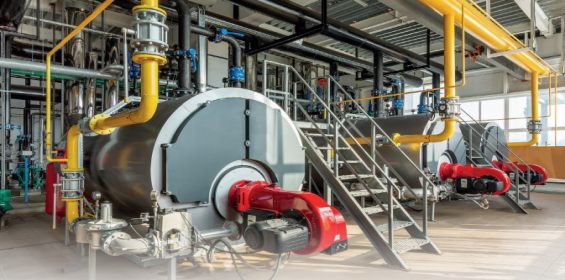What are the implications of de-rating boiler pressure?
Published: 09 November, 2022
In these days of pushing the boundaries on energy efficiency it’s very easy to connect a lower working temperature in a boiler to a lower flue gas temperature and therefore higher efficiency but is that really the case? The Combustion Engineering Association (CEA) explains further.
While it’s true that a 15°C reduction in flue gas temperature will save most steam users 1% of the boiler running cost, it isn’t quite that simple when it comes to looking at the effect on the system as whole.
Let’s look at the facts:
One thing to remember is that you still need to move the same amount of energy so lower pressure steam will need to travel faster through the same pipes. Good design practice says that one should design for around 25 m/s in a pipeline with an upper limit of 40 m/s in exceptional circumstances. That could mean that some of the steam pipework will need to change to accommodate the lower pressure. If you stick with the existing pipework you will experience:
- Increased pressure losses; a 6” pipe exposed to 10 bar steam at 25 m/s will experience a pressure, drop of 21 mbar along a 10m straight length compared to the same mass of steam entering at 6 bar (40 m/s) experiencing 32mbar of loss. This may not sound much but this is a relatively short piece of straight pipe, once you factor in a longer pipe run, isolation valves, a strainer, and a control valve the pressure drop could be considerable.
- Increased noise; in the above example the 10-bar steam line would have a noise of 62 dB(A) compared to 72 dB(A) for the 6 bar line; add in some other noise or perhaps even a control valve or steam meter, and you could easily take the noise above 80 dB(A).
Control valves and steam meters are usually sized with a much higher velocity so it is extremely important to check their suitability for the new operating conditions with a specialist; they simply may not be able to pass the same mass of steam at the lower pressure. High velocity is also problematic inside the boiler. As the pressure falls, the size of steam bubbles increases and the required volume flow to achieve a given mass flow, also increases; this leads to a much more violent reaction inside the boiler and potentially problems with water level control and an increase in carry-over. The increase in water leaving the boiler greatly reduces the heat carrying capacity of the pipe since the water cannot impart any heat, it simply serves to restrict the volume of steam that the line can carry.
Like many valves, steam trap capacities are linked to the pressure drop across them; lowering the inlet pressure will undoubtedly reduce the capacity of the steam trap; a double- whammy when added to the increased demands on the trap resulting from increased carryover; all steam traps in the system should be assessed for suitability for the lower operating pressure The boiler safety valve is an often over-looked area when considering the reduced pressure. An important point to remember is that the valve is there to protect the boiler and not the downstream system, so it is possible to run a boiler at a lower working pressure without having to alter the safety valve set pressure unless the Competent Person has specifically requested it.
When changing the set pressure of a safety valve it is essential that you consult either the boiler maker, or the manufacturer of the valve to ensure its continued suitability since a reduction in set pressure will also mean a reduction in valve capacity.
If you find you need a larger safety valve you will also need to change the inlet and outlet pipes to suit. Importantly, the pipes must be sized for the flowrate of the valve at the relieving pressure, NOT the capacity of the boiler (which could be considerably lower) so any calculations of flow capacity must include the pipe arrangement. The inlet line losses must not exceed 3% of the valve set pressure or there is a risk that the valve becomes unstable, restricting the flow through the valve and potentially causing it to close prematurely. Once the valve lifts, the boiler must not increase in pressure by more than another 10%.
Most importantly, you MUST notify your Competent Person (the people who approved your Written Scheme of Examination) BEFORE you make any changes. They will expect to see supporting risk assessments and calculations to show that what you are proposing to do is safe and will want to witness at least the final testing as well as update the Written Scheme.
So, is it appropriate on your plant to reduce the boiler operating pressure with a view to saving money on fuel costs when you consider both the effects on the plant and equipment and the associated risks of making the necessary changes?
https://twitter.com/CombEngAss
https://www.linkedin.com/company/combustionengineeringassociation/







